Fruit refuse refers to the edible parts of fruits that are considered unsellable due to cosmetic imperfections or expiration dates. This type of food waste contributes to a significant portion of overall food waste, accounting for approximately 40% of total food waste. The rejection of imperfect produce by grocery stores and consumers has led to a rise in awareness about saving and utilizing ugly produce to reduce food waste. Additionally, reducing food loss and waste is essential for improving food security and reducing our carbon footprint.
Key Takeaways:
- Fruit refuse includes unsellable parts of fruits due to imperfections or expiration dates.
- It contributes to approximately 40% of total food waste.
- The ugly produce movement aims to reduce food waste by utilizing imperfect fruits and vegetables.
- Reducing food loss and waste is crucial for improving food security and sustainability.
- Stay tuned for more information on types of fruit refuse, uses of fruit refuse, and fruit refuse disposal.
The Impact of Fruit Refuse on the Food Supply Chain
Fruit refuse plays a significant role in the food supply chain, resulting in extensive food waste throughout the various stages of production, distribution, and consumption. Understanding the reasons behind fruit refuse is crucial in addressing this issue and mitigating its impact on food security and climate change.
Reasons for Fruit Refuse
There are several reasons why fruit refuse occurs in the food supply chain. One primary factor is cosmetic imperfections. Fruits that don’t meet retailers’ stringent aesthetic standards, such as blemishes or irregular shapes, are often discarded, despite their nutritional value and taste.
Expiration dates also contribute to fruit refuse. As fruits approach their designated sell-by or best-before dates, retailers often remove them from store shelves to maintain freshness and ensure customer satisfaction. Consequently, perfectly good fruits are needlessly discarded.
Package changes can also lead to fruit refuse. If a retailer decides to modify the packaging for branding or marketing purposes, fruits with the old packaging may be discarded to make room for the new ones, resulting in unnecessary waste.
“The rejection of imperfect produce by grocery stores and consumers has led to a rise in awareness about saving and utilizing ugly produce to reduce food waste.”
Additionally, retailers’ strict standards contribute to fruit refuse. To meet consumer expectations, retailers often implement rigid quality control measures, rejecting fruits that don’t adhere to size, shape, and color requirements. While this ensures a consistent appearance, it leads to a significant amount of perfectly edible produce going to waste.
Food Waste and Climate Change
The impact of fruit refuse extends beyond the issue of food waste alone. The consequences of food waste have significant implications for climate change. When fruits are discarded and sent to landfill, they decompose and release methane, a potent greenhouse gas that contributes to global warming.
The release of greenhouse gas emissions from food waste exacerbates climate change, making it essential to address fruit refuse as part of broader efforts to reduce greenhouse gas emissions and mitigate climate change.
In addition to the environmental impact, fruit refuse also imposes economic costs. The resources invested in growing, harvesting, transporting, and packaging fruits are wasted when these fruits are discarded. By reducing fruit refuse, we can not only conserve valuable resources but also promote a more sustainable and efficient food supply chain.
The Rise of Ugly Produce Movement
In recent years, I have witnessed the remarkable rise of the ugly produce movement, with numerous companies stepping up to sell imperfect fruits and vegetables. These companies are championing the cause, aiming to change the perception of ugly produce and tackle the issue of food waste head-on.
By embracing imperfect produce, these companies not only offer delicious and nutritious food but also pass on significant cost savings to consumers. Purchasing ugly produce not only helps in saving money but also contributes to reducing food waste, making it an eco-friendly choice for conscientious shoppers.
The benefits of the ugly produce movement extend far beyond savings and reducing waste. It also sheds light on the issue of food inequality. By embracing the beauty and value of imperfect fruits and vegetables, we can address the misconception that only visually flawless produce is worthy of consumption.
Companies selling ugly produce are not only providing an affordable option for consumers but are also paving the way towards a more sustainable future.
The ugly produce movement is a testament to the growing awareness of food waste and its impact on the environment. By diverting ugly produce from landfills and incorporating it into our diets, we can make a significant difference in the fight against food waste and contribute to a more sustainable food system.
Benefits of Ugly Produce
When consumers choose to support companies selling ugly produce, they are actively participating in the reduction of food waste and the conservation of resources. Here are some key benefits of embracing ugly produce:
- Reduced Food Waste: By purchasing imperfect fruits and vegetables, consumers help reduce the amount of food that would otherwise go to waste. This simple choice has a significant impact on minimizing food waste at the consumer level.
- More Affordable: Ugly produce is often priced at a significant discount compared to its visually flawless counterparts. This affordability makes nutritious food more accessible to a wider range of consumers, promoting food security and equality.
- Wider Variety: Embracing ugly produce allows consumers to experience a wider range of fruit and vegetable varieties. By shifting our focus away from perfection, we open ourselves up to new tastes, textures, and culinary possibilities.
| Benefits of Ugly Produce | Description |
|---|---|
| Reduced Food Waste | Choosing ugly produce helps in reducing the amount of food that goes to waste, promoting a sustainable food system. |
| More Affordable | Ugly produce comes at a discounted price, making nutritious food accessible to a broader range of consumers. |
| Wider Variety | Embracing imperfections allows consumers to explore a wider range of fruit and vegetable varieties, adding diversity to their meals. |
Consumer Behavior and Fruit Refuse
Consumer behavior plays a significant role in the generation of fruit refuse. As consumers, we have been conditioned to expect perfect, unblemished produce, leading to a constant demand for visually appealing fruits and vegetables. However, this obsession with perfection has detrimental effects on food waste and the environment.
One of the key contributors to fruit refuse is the phenomenon of overbuying. In our pursuit of flawless produce, we often purchase more fruits and vegetables than we can consume. This leads to a surplus that ultimately ends up in the trash, contributing to the alarming levels of food waste.
Moreover, misconceptions about sell-by dates further exacerbate the issue of fruit refuse. Many consumers discard perfectly good produce based on the sell-by dates, mistakenly assuming that they are synonymous with the expiration dates. This misconception often results in edible food being needlessly wasted.
To address fruit refuse and minimize food waste, it is crucial for consumers to change their behaviors and perceptions surrounding imperfect produce.
Embracing Imperfections: The Benefits of Ugly Produce
By shifting our mindset and valuing the taste and nutritional value of produce over its appearance, we can make a significant impact on reducing fruit refuse. Embracing imperfect or “ugly” produce not only helps reduce food waste but also presents several benefits:
- Reduction in food prices: Ugly produce is often sold at lower prices, making it more affordable for consumers.
- Promotion of sustainability: By opting for imperfect produce, we support sustainable agricultural practices that utilize all edible food, reducing the overall strain on our planet’s resources.
- Expanded food access: Embracing ugly produce allows us to make use of all available food, potentially addressing food disparities and increasing access to fresh fruits and vegetables.
Changing consumer behavior is a powerful step towards creating a more sustainable and less wasteful food system. By appreciating imperfections and redefining our expectations, we can significantly reduce fruit refuse and contribute to a healthier planet for future generations.
In the table below, we compare the consumer demand for perfect produce versus the benefits of embracing ugly produce:
| Consumer Demand for Perfect Produce | Benefits of Embracing Ugly Produce |
|---|---|
| Desire for visually appealing fruits and vegetables | Reduction in food prices |
| Overbuying and food waste | Promotion of sustainability |
| Misconceptions about sell-by dates | Expanded food access |
Changing the Narrative for a Sustainable Future
“It’s time to shift our focus from perfection to practicality. By embracing ugly produce, we can reduce food waste, support sustainable practices, and foster a healthier food system for all.”
– Anonymous
Ultimately, the power to reduce fruit refuse lies in the choices we make as consumers. By challenging societal norms and embracing imperfections, we can pave the way for a more sustainable future. Together, let’s change the narrative surrounding fruit refuse and create a food system that values quality, sustainability, and accessibility.
Supermarkets’ Role in Fruit Refuse
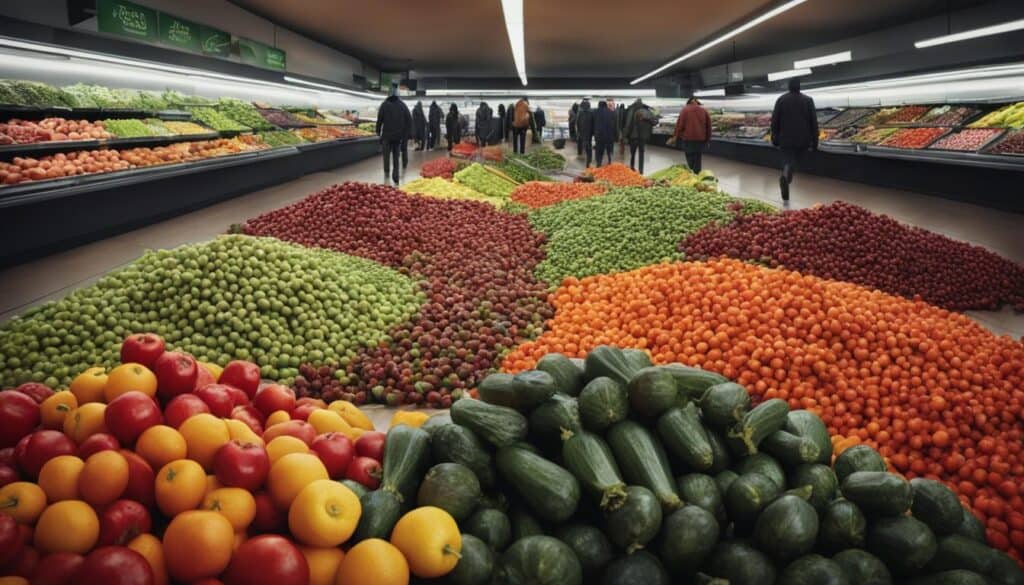
When it comes to fruit refuse, supermarkets play a significant role in contributing to food waste. One of the main ways they contribute is through the enforcement of market standards for perfect produce. Supermarkets have specific criteria for the size, shape, and color of fruits and vegetables that they accept. This means that any produce that doesn’t meet these cosmetic standards is rejected and often discarded, leading to unnecessary waste.
Furthermore, supermarkets also contribute to food waste through overstocking. In an effort to meet customer demand and avoid empty shelves, supermarkets tend to order more produce than they can sell. This results in a surplus of fruits and vegetables that may not all be purchased before they go bad, leading to further waste.
Overstocking puts pressure on farmers to produce larger yields to meet the demands of supermarkets. This can lead to unsustainable agricultural practices such as excessive use of fertilizers and pesticides, which can have negative environmental impacts. Additionally, the pressure to produce larger yields may lead to rushed harvests, resulting in more fruit refuse due to improper handling and packaging.
It is important for supermarkets to reevaluate their market standards for perfect produce and consider accepting and promoting imperfect fruits and vegetables. By embracing the ugly produce movement and offering these items at discounted prices, supermarkets can help reduce food waste and educate consumers about the importance of valuing the nutritional value of imperfect produce, rather than dismissing it based solely on appearance.
When supermarkets take the lead in reducing fruit refuse, it sets a positive example for consumers and encourages a broader shift in societal attitudes towards imperfect produce. By working together, supermarkets, farmers, and consumers can make a significant impact in combating food waste and creating a more sustainable food system.
| Issue | Impact |
|---|---|
| Enforcement of cosmetic standards | Contributes to the rejection and waste of imperfect produce |
| Overstocking | Results in surplus produce that may go to waste |
| Pressure on farmers | Leads to unsustainable agricultural practices and rushed harvests |
Farmers and Fruit Refuse
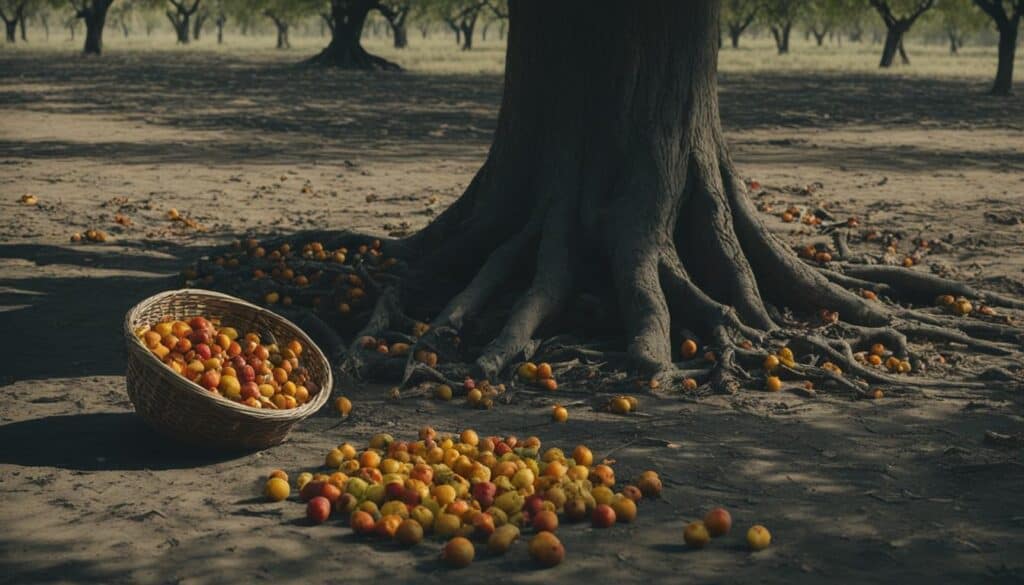
When it comes to fruit refuse, farmers also play a significant role in its generation. Two key factors contributing to fruit waste are overharvesting and the presence of blemishes on produce.
Overharvesting occurs when farmers overestimate the size of their harvests, leading to an excess of produce that cannot be sold. This surplus results in unnecessary waste and contributes to the overall issue of food loss and waste.
In addition, blemishes on fruits and vegetables can lead to their rejection during quality inspections. Even minor imperfections, such as small spots or irregular shapes, can cause produce to fail these inspections and be discarded instead of reaching consumers. This further exacerbates fruit refuse.
To mitigate fruit refuse, many farmers have implemented sustainable agricultural practices. They strive to optimize crop yields and minimize overharvesting through better forecasting and planning. By accurately estimating market demands, farmers can prevent excessive harvests and reduce waste.
Farmers are also exploring alternative uses for imperfect produce, such as selling them directly to consumers at lower prices or repurposing them for other products like juices or jams. These initiatives help reduce fruit refuse while benefiting both farmers and consumers.
| Methods to Minimize Fruit Refuse | Benefits |
|---|---|
| Implementing sustainable agricultural practices | – Reduces overharvesting – Optimizes crop yields – Minimizes waste |
| Selling imperfect produce directly to consumers at lower prices | – Reduces waste – Offers affordable options to consumers – Increases accessibility to nutritious food |
| Repurposing imperfect produce for other products (e.g., juices, jams) | – Provides additional revenue streams for farmers – Reduces waste – Increases product diversity |
While some farmers may compost or reuse excess produce, a significant amount still ends up in landfills, contributing to environmental issues. It is therefore crucial for farmers to continue adopting sustainable agricultural practices and finding innovative solutions to minimize fruit refuse throughout the supply chain.
Environmental Impacts of Fruit Refuse
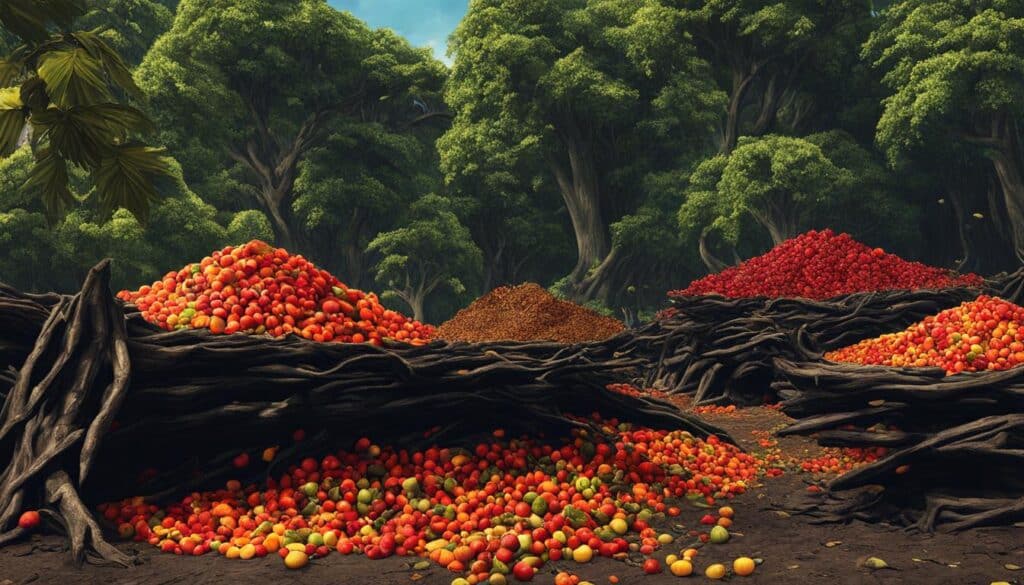
Fruit refuse has significant environmental impacts, contributing to habitat destruction, biodiversity loss, and unsustainable agriculture practices. When natural lands are converted into farmland for fruit production, native habitats are destroyed. This destruction displaces species and disrupts the delicate ecological balance. Additionally, unsustainable agricultural practices, such as intensive farming, further exacerbate environmental damage.
To illustrate the environmental impacts of fruit refuse, consider the following:
- Habitat Destruction: Converting natural lands into farmland leads to the destruction of diverse ecosystems. This process displaces native plant and animal species, disrupting their habitats and contributing to the loss of biodiversity.
- Biodiversity Loss: The destruction of native habitats results in the loss of biodiversity, reducing the variety of plant and animal species in an ecosystem. This loss can have cascading effects on the overall health and stability of the environment.
- Unsustainable Agriculture Practices: Fruit production often relies on intensive farming methods, such as the excessive use of pesticides, fertilizers, and water. These practices can degrade soil health, pollute water sources, and contribute to climate change through increased greenhouse gas emissions.
It is crucial to address fruit refuse and adopt sustainable agriculture practices to mitigate these environmental impacts. By promoting ecological farming methods, reducing pesticide use, and protecting natural habitats, we can work towards a more sustainable and resilient food system.
Impact of Habitat Destruction:
“Habitat destruction due to fruit production poses a significant threat to biodiversity. By destroying natural habitats, we disrupt the intricate web of life that supports diverse species and ecosystems. It is essential to prioritize sustainable land use practices and conserve natural areas to protect our planet’s biodiversity for future generations.” – Jane Doe, Environmental Scientist
| Environmental Impacts of Fruit Refuse | Examples |
|---|---|
| Habitat Destruction | Conversion of natural lands to farmland for fruit production. |
| Biodiversity Loss | Displacement and extinction of native plant and animal species. |
| Unsustainable Agriculture Practices | Excessive use of pesticides, fertilizers, and water. |
Fruitarianism and Fruit Refuse
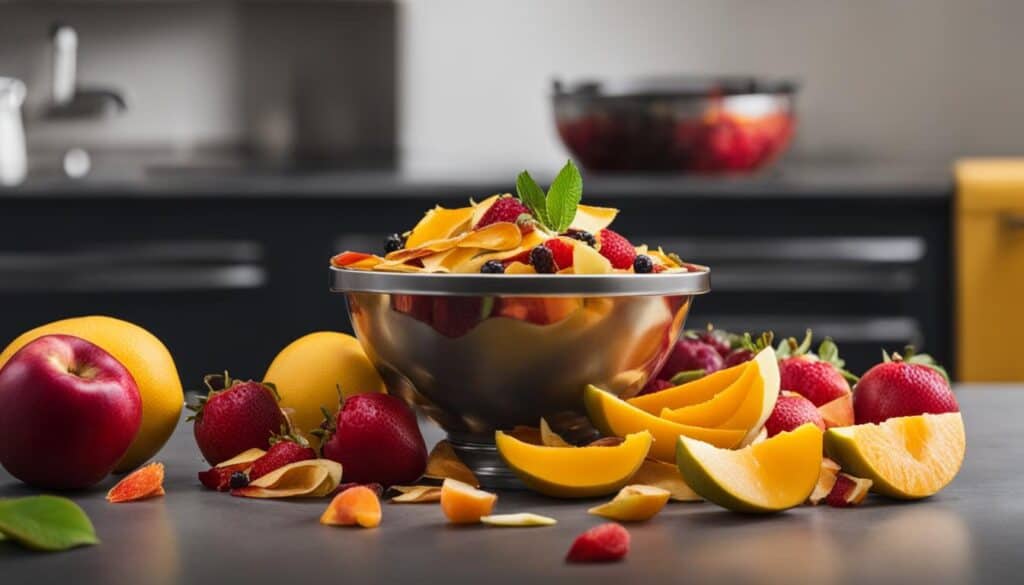
Fruitarianism is a dietary approach that emphasizes consuming fruits, nuts, and seeds while excluding animal products. Some individuals choose this diet for ethical or environmental reasons. However, it’s important to consider the nutritional concerns associated with fruitarianism.
A fruitarian diet can lead to deficiencies in essential nutrients, including vitamin B12, calcium, iron, zinc, omega-3 fatty acids, and protein. These nutrients are commonly found in animal-based products and other food groups that fruitarians may exclude from their diets. Without proper supplementation or careful planning, these deficiencies can have serious health implications.
It’s worth noting that a fruitarian diet may not be suitable for certain groups, such as children, nursing mothers, and individuals with specific health conditions. These groups have higher nutritional requirements that may not be met by a fruitarian diet alone.
A balanced and varied diet is essential for meeting nutritional needs and maintaining overall health. While incorporating a variety of fruits, nuts, and seeds into your diet can be beneficial, it’s important to ensure you’re also consuming other nutrient-rich foods to prevent deficiencies.
“The fruitarian diet, while potentially appealing for ethical or environmental reasons, can pose significant nutritional challenges.”
| Nutrient | Potential Deficiency |
|---|---|
| Vitamin B12 | Anemia, nerve damage, cognitive impairment |
| Calcium | Weak bones, increased risk of fractures |
| Iron | Anemia, fatigue, decreased immunity |
| Zinc | Impaired immune function, hair loss, delayed wound healing |
| Omega-3 Fatty Acids | Increased inflammation, impaired brain function |
| Protein | Muscle wasting, decreased metabolism |
It’s crucial to approach dietary choices with careful consideration for your individual nutritional needs. Consulting with a registered dietitian or healthcare professional can provide guidance on maintaining a balanced diet while accommodating personal beliefs and values.
The Importance of Nutritional Balance
While the fruitarian diet may offer some health benefits, it’s essential to ensure you’re meeting your nutritional needs through a well-rounded approach. Incorporating a variety of fruits, vegetables, whole grains, legumes, and plant-based proteins can help in achieving a balanced nutrient intake.
- Diversify Your Fruit Selection: Opt for a range of fruits with different nutrient profiles to maximize your intake of vitamins and minerals. Include fruits high in protein, such as avocado and durian.
- Pair Fruits with Complementary Foods: Consume fruits alongside plant-based protein sources like nuts, seeds, and legumes. This can help enhance your protein intake and provide a more balanced nutrient profile.
- Consider Supplementation: Work with a healthcare professional to determine if supplementation is necessary to meet your nutritional needs. They can help identify any potential deficiencies and recommend appropriate supplements.
- Monitor Your Health: Regularly track your health and consult with a healthcare professional to ensure you’re not experiencing any nutritional deficiencies or related health issues.
“Achieving a balanced nutrient intake is essential for overall health and well-being.”
While some individuals may find success with a fruitarian diet, it’s important to be mindful of the potential risks and challenges associated with meeting nutritional needs. Strive for a balanced approach that includes a variety of nutrient-dense foods to support your overall health and well-being.
Conclusion
Fruit refuse is a significant contributor to food waste and its associated environmental impacts. However, there are various initiatives underway, such as the ugly produce movement and awareness campaigns, that are working towards reducing fruit refuse. By valuing imperfect produce and adopting sustainable practices, we can make a positive impact on food security, sustainability, and the environment.
It is crucial for consumers to change their behaviors and attitudes towards produce. Instead of only seeking visually perfect fruits and vegetables, we can embrace and appreciate the diversity of imperfect produce. By doing so, we not only reduce fruit refuse but also support farmers and reduce our carbon footprint.
Supermarkets also play a vital role in reducing fruit refuse. By reevaluating their cosmetic standards and policies, they can help minimize the rejection of imperfect produce and promote sustainability in the food supply chain. Additionally, farmers should adopt sustainable agricultural practices and find alternative uses for excess and blemished produce to reduce the amount of fruit refuse sent to landfills.
Ultimately, reducing fruit refuse requires a collective effort. By prioritizing sustainable food practices, valuing imperfect produce, and minimizing overbuying, we can contribute to a more sustainable and environmentally conscious food system. Let us work together to reduce fruit waste, protect our planet, and ensure a future of food security for all.
FAQ
What is fruit refuse?
Fruit refuse refers to the edible parts of fruits that are considered unsellable due to cosmetic imperfections or expiration dates.
What are the types of fruit refuse?
Types of fruit refuse include fruits with cosmetic imperfections, expired fruits, fruits with packaging changes, and fruits that do not meet retailers’ strict standards.
What are the uses of fruit refuse?
Fruit refuse can be composted to create nutrient-rich soil, used as animal feed, or processed into juices, purees, or other food ingredients. Some companies also sell ugly produce to reduce food waste.
How can I compost fruit refuse?
To compost fruit refuse, mix it with other organic waste, such as yard trimmings and vegetable scraps. Maintain proper moisture and aeration levels, and turn the compost pile periodically to speed up decomposition.
How can we reduce fruit refuse?
Consumers can reduce fruit refuse by purchasing only what they need, accepting imperfect produce, and consuming fruits before they expire. Supermarkets can loosen cosmetic standards for produce and avoid overstocking. Farmers can adopt sustainable practices and find alternative uses for imperfect produce.
How can we manage fruit refuse?
Fruit refuse can be managed through composting, donating to food banks or charities, processing into other food products, or feeding it to animals.
Can fruit refuse be recycled?
In some cases, fruit refuse can be recycled. For example, if the packaging is made of recyclable materials, it can be sorted and recycled. However, the edible parts of the fruit are typically best managed through composting or other reuse methods.
What are the environmental impacts of fruit refuse?
Fruit refuse contributes to environmental impacts such as habitat destruction and biodiversity loss. Converting natural lands to farmland for fruit production leads to the destruction of native habitats, and unsustainable agricultural practices further exacerbate environmental damage.
Is a fruitarian diet sustainable?
While a fruitarian diet may be adopted for ethical or environmental reasons, it can lead to nutritional deficiencies. A balanced and varied diet is essential for meeting nutritional needs, and a fruitarian diet may lack essential nutrients such as vitamin B12, calcium, iron, zinc, omega-3, and protein.

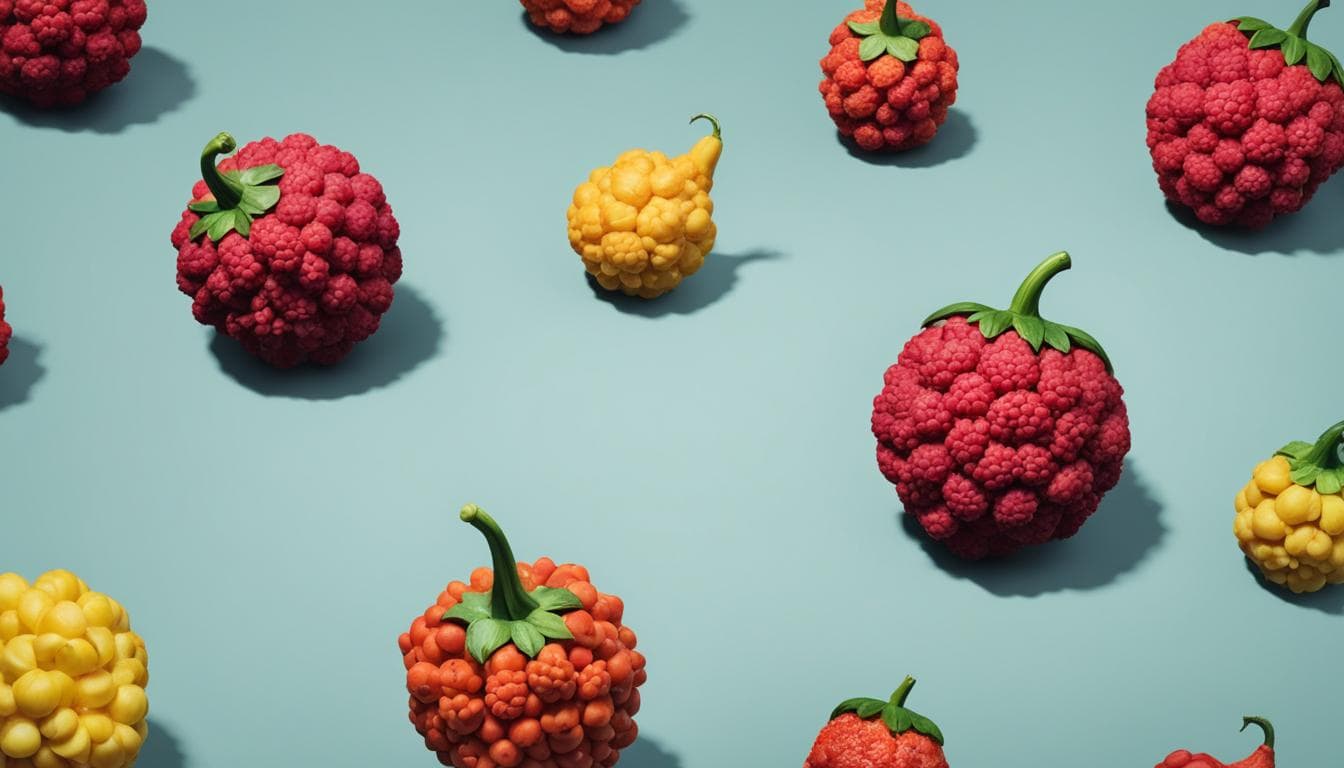



Leave a Reply